This reading made me feel depressed and anxious. I feel a sense of weirdness that is difficult to describe.
In the beginning, the completely automated environment already gives me a sense of anxiety. Immediately, the thought of letting automatons take over the simple actions in our day-to-day lives makes humans seem inefficient and almost obsolete compared to the machines that can do it better. Then we get to the part of the story where we release that it takes place in a world where humans no longer exist anymore. However, even in the absence of humans, the machines go on working as if nothing had happened, and their efforts are fruitless. However, I suppose everyone and everything has a purpose, and we all exist to serve that purpose, so I guess that in itself is not "fruitless."
The most exciting and also unsettling aspect of this work is the personification of the house and all of its functions. There seems to be this frantic energy all around the house, and its juxtaposition to its lack of inhabitants is the unsettling part. Do you remember the scary feeling of being home alone when you hear strange noises in your house, but it turns out to be nothing? Well the automated house seems like those strange noises, yet they are the ones taking charge and who are not frightened. The roles are reversed.
As far as relating this story to this sensors class, I guess machines, which rely so much on humans for creation, can function way beyond the existence of humans. It's like the poem from the story:
"Not one would mind, neither bird nor tree,
if mankind perished utterly;
And Spring herself, when she woke at dawn
Would scarcely know that we were gone."
A machine could never fathom its existence, and would not really give a damn if it were to perish. However in this story, the house struggles so hard to keep intact and tries to save itself, even when any and all hope of usefulness has gone. It struggled so hard just to exist, and nothing more. The house trying to cling to life seems like it would be exhibiting a human characteristic, but at some point, even a human will lose the will to live if there is nothing to live for. As much as an automaton can be programmed to behave like a human, sometimes logic varies.
-Netalia
















